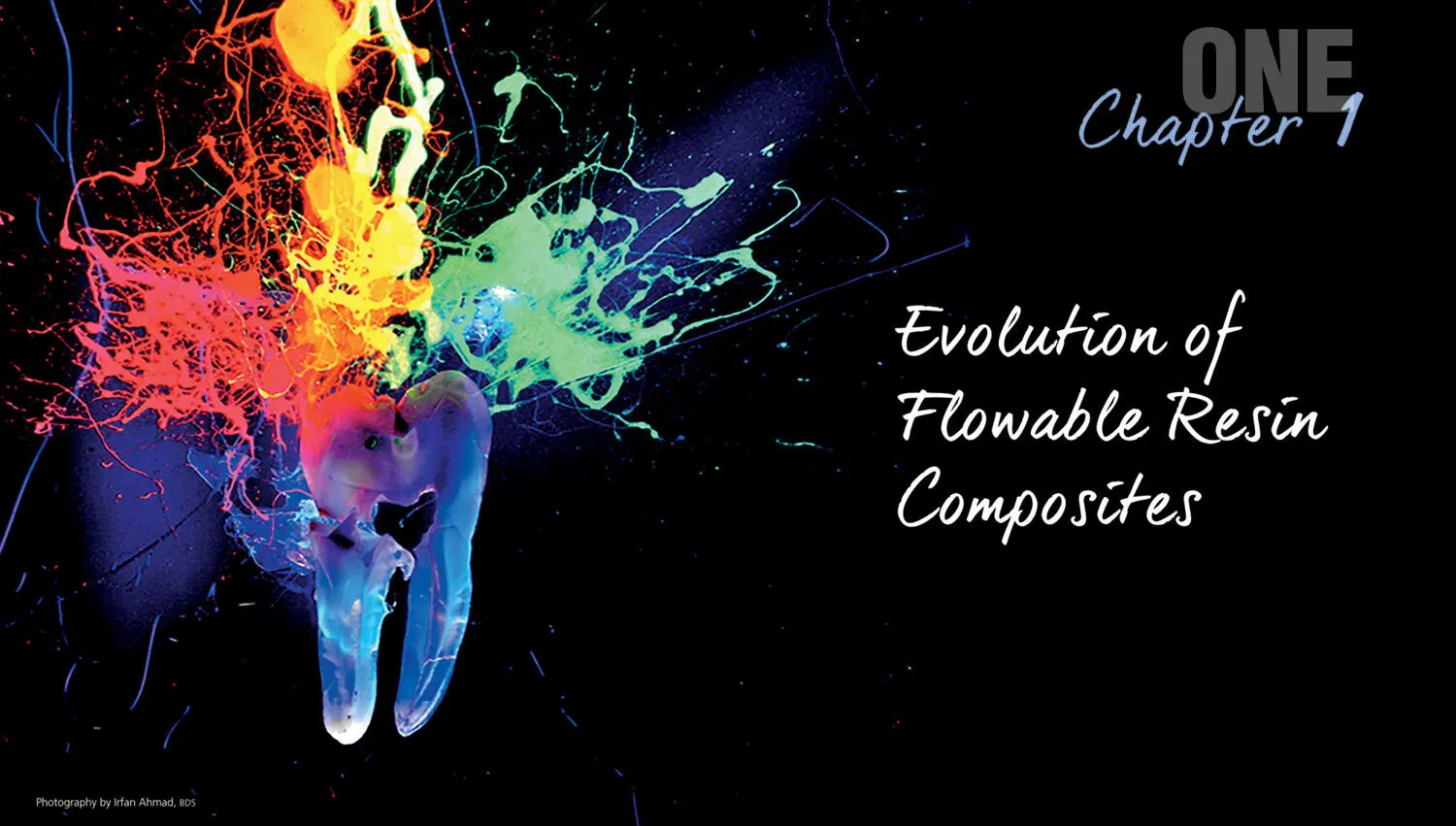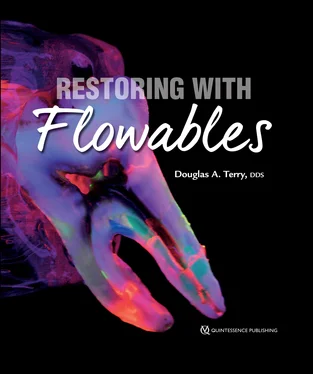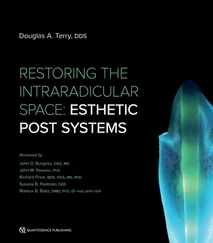The purpose of this text is to provide the clinician and technician with information to develop and stimulate their powers of observation, imagination, evaluation, decision-making, and application of flowable resin composites. It provides a detailed presentation of the inverse injection layering technique, which can be used for provisional restorations, pediatric crowns, posterior restorations, provisional restoration repair, resurfacing existing resin restorations, and prototyping during interdisciplinary treatment such as crown lengthening, ovate pontic development, and development of the peri-implant region during implant therapy. The follow-up results shown in this book provide not only the technique and materials to develop natural-looking restorations but also sound evidence that these highly filled flowable materials have significance in improving the practice of dentistry.
The text provides a detailed and scientific description of the evolution of flowable resin composites and the adhesive design concept and illustrates the same order of development that I use in my restorative procedures with the inverse injection layering technique. A detailed presentation of the various adhesive preparation designs, applications and restorative techniques, adhesive protocols, and finishing procedures is also provided. The scientific data and microscopic illustrations are intertwined to provide clarity and evidence for these procedures. In addition, chapter 2provides a detailed description of the light-curing unit (by Richard Price) and the significance of understanding its mechanism for proper selection and use, which play an integral role in the adhesive design concept for optimal bonding. The majority of the book demonstrates the information presented in the early chapters through illustrated case presentation. My desire is that these clinical and laboratory procedures may provide another vantage point for the clinician and technician in their pursuit of excellence in restorative dentistry.
My inspiration for writing this book and sharing photographs of these procedures can be attributed to my dear colleagues and students around the world who have expressed interest during presentations and hands-on courses. Compilation of this information would not have been possible without the dedication, persistence, and relentless hard work and long hours of my dear friend and personal assistant, Melissa Nix, who instilled confidence and offered continual support in writing and organizing this information. My mother’s great ability to persuade patients to return for follow-up photographs along with her support and dinners for the team have allowed us to complete this project. Furthermore, this project would not have seen the light of day without the dedication, relentless organization, persistence, and imagination of the Quintessence team. Also, I would like to express my gratitude to my team—Dr John Powers, Dr Jean-François Roulet, Dr Markus B. Blatz, Dr Alejandro James, Dr Wesam Salha, and technicians Victor Castro, Alex Schuerger, Jungo Endo, August Bruguera, and Olivier Tric—for their patience, commitment, and midnight hours to complete this endeavor. More importantly, I would like to thank my patients without whom this project would not have been possible.
Of special significance in my life is my teacher, Maestro Willi Geller, whose friendship and early-morning conversations in the cellar have expanded my understanding and vision of esthetic dentistry and, more importantly, of life. And of course I must thank my colleagues in Oral Design for their friendship and brotherhood. Finally, I give special thanks to my Creator who makes me realize that teeth are simple in His hands but so complex in mine.

Contributors
Scientific Reviewers and Contributors
Irfan Ahmad, BDS
Alejandro James, DDS, MSD
John M. Powers, PhD
Richard Price, BDS, DDS, MS, PhD
Jean-François Roulet, DDS, PhD
Clinical and Laboratory Contributors
Venkatesh Babu, BDS, MDS
August Bruguera, CDT
Victor E. Castro, CDT
Jungo Endo, RDT
Kim S. Gee, DDS, MS
Bassam Haddad, CDT
Yoshihiro Kida, DDS, PhD
Usha H. L., BDS, MDS
Deepak Mehta, BDS, MDS
Alireza Sadr, DDS, PhD
Wesam Salha, DDS, MSD
Ashwini Santosh, BDS, MDS
Alex H. Schuerger, CDT
Olivier Tric, MDT
Hiroyuki Wakatsuki, DDS
Francisco Zarate, DDS, CDT

Historical Perspective
The year 1996 was an exciting one all over the world. The Dow Jones Industrial Average reached a record high of 6,000; the Nobel Prize in Chemistry was awarded to Robert F. Curl Jr, Harold W. Kroto, and Richard E. Smalley for their discovery of fullerene, a molecule composed entirely of carbon; General Motors launched the first electric car of the modern era; divers discovered the ancient port of Alexandria; eBay opened its doors for business; DVDs hit the market in Japan; Will Smith made his electrifying performance in the film Independence Day; David Bowie was inducted into the Rock and Roll Hall of Fame; and flowable resin composites were developed and introduced to the world as a revolutionary restorative biomaterial. 1 The average individual would probably rank this discovery as the least significant of these events, but this milestone dramatically affected the practice of adhesive dentistry.
The evolution of adhesive dentistry, with filled adhesives and sealants, led to the development and discovery of flowable resin composites. However, it was not until 1996 that these biomaterials had their own identity and became known as flowables. These first-generation flowable formulations were designed to simplify the placement technique and to expand the range of clinical applications for resin composites 1 , 2 They were configured by using filler particle sizes identical to those of conventional hybrid composites while reducing the filler load and/or increasing the diluent monomers. 3 , 4 Thus, a multitude of variations in viscosity, consistency, and handling characteristics were available to the discriminating clinician for addressing many of the restorative and esthetic challenges presented to them each day.
These biomaterials were marketed by manufacturers for a wide range of applications, which included all classifications of anterior and posterior composite restorations, amalgam margin repair, block-out materials, composite repair, core buildup, crown margin repair, cavity liners, pit and fissure sealants, porcelain repair, anterior incisal edge repair, preventive resin restorations, provisional repair, porcelain veneer cementation, composite veneer fabrication, tunnel preparation restorations, adhesive cementation, restoring enamel defects, air abrasion cavity preparations, and void repairs in conventional resin composite restorations. 1 , 5 Unfortunately, these early flowable formulations demonstrated poor clinical performance, with inferior mechanical properties such as flexural strength and wear resistance compared with the conventional hybrid composites. 1 , 2 In fact, the mechanical and physical properties of composite materials improve in proportion to the volume of filler added, 6 and the filler content of these early flowable formulations was reported to be 20% to 25% by weight less than that of the universal composite materials. 1 Numerous mechanical properties depend on this filler phase, including compression strength and/or hardness, flexural strength, elastic modulus, coefficient of thermal expansion, water absorption, and wear resistance. 6 Thus, a reduction in the filler content of these first-generation flowables substantiates the reports by Bayne et al, 1 which state that the mechanical properties of these low-viscosity materials were approximately 60% to 80% of those of conventional hybrid composites. One scientific study 7 reported that a comparison of flowable light-cured resin composites and conventional resin composites of the same brand name had very different characteristics and mechanical properties. Early attempts to use these flowable formulations in a wide variety of applications resulted in shortcomings that led to confusion and uncertainty for clinical predictability and performance when using these biomaterials. These shortcomings resulted in limitations on the expanded applications previously suggested by the manufacturer. Clinicians realized that these first-generation flowable composites were neither the same nor adequate substitutes for the highly filled conventional composites.
Читать дальше













